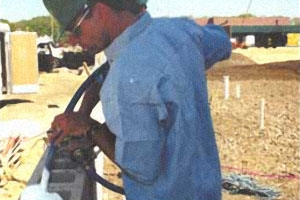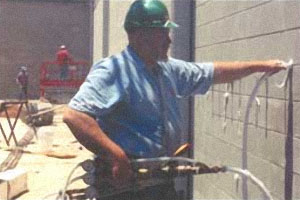Foamed-in-Place Insulation: Growing in Popularity
By Norm Royce

The growing popularity of generic foamed-in-place insulation is benefiting mason contractors across America because they are finding the price, effectiveness and convenience of using this product can cut labor costs and increase profits while providing an energy efficient wall.
Some call it an amino-plast resin, while others prefer oligomeric polymethylene carbonate. The most descriptive word for all these products, however, is urea-formaldehyde foam insulation.
The product is being used in everything from schools, high-rises, retail boxes, and football stadiums to basement foundation walls and hollow-core concrete panels. Yet, architects and contractors alike know very little about it. Questions abound regarding its physical attributes, correct application techniques, chemical composition and potential hazards, and quality control procedures.
The most common point of confusion is how it compares to polyurethane foam insulation, a generically different product with completely different physical properties. One thing is assured, twenty years after the rebirth of urea-formaldehyde foam insulation, it has proven its effectiveness and popularity within the block industry.
The vast majority of contractors pumping foam in the '70s were home improvement contractors. The foam was the ideal product for injecting into uninsulated walls, significantly increasing the R-value (resistance to heat and cooling loss) of the walls of most homes. At its peak in the early 1980s, it is estimated that over 1200 contractors were pumping foam in the United States and Canada. By 1982, though, the growth of this booming industry came to a screeching halt.
In 1982, the Consumer Product Safety Commission (CPSC) forced the product off the market, alleging that it was a carcinogen. With the immense amount of publicity and media attention that followed, the product was soon limited to commercial applications.
In April 1983, the U S Court of Appeals for the Fifth Circuit overturned the ban, stating that the CPSC's data and methodology was "not good science." The court criticized the claim that foams presented a cancer risk of between 0 and 51 in a million. On close examination it was found that the U.S. Chemical Industry Institute of Toxicology's report that found formaldehyde caused nasal cancer in rats (not mice, in the same experiment), was based on an exposure to formaldehyde at levels 300 to 600 times greater than the normal exposure in an average house. While the ban was overturned, the damage was done to a relatively young and vulnerable growth industry.

Over the past 20 years, the product has re-defined itself as the ideal product for core filling concrete masonry units. The foam is injected through small holes in the mortar joints or top-filled into the cells where it flows under about 55 - 75 psi of air pressure. When fresh, it looks like a thick shaving cream, drying or "curing" to a consistency similar to a stale angel food cake.
As it is injected, it seeks out and fills all available air spaces, providing an excellent insulation value for the integral wall unit. Unlike loose fill materials, it will not settle or flow out weep holes.
The complex chemical nature of the three-component foam creates some interesting physical characteristics. Produced at the job-site by the installing contractor, the foam consists of a urea-formaldehyde liquid resin, a liquid emulsifier or foaming agent with a catalyst, and compressed air. When these three agents merge at the end of the application gun, the initially acid mixture becomes neutral. To effectuate a complete reaction, a minimum length of four to six feet of application hose is required. The foam will flow out the application hose and move throughout the wall until it reaches its setting point. At this time it solidifies and prevents further flow. Once the foam sets up, it cannot be broken down by water.
While often referred to as a "40 percent open, 60 percent closed cell" product, the cellular structure is more accurately described as an interspersed capillary structure. This makes it ideally suited for sound insulation and the tiny air cells make it an excellent insulator with R-values ranging from 4.7 to 5.2 per inch.
The density of the product varies greatly from its initial installed wet stage of approximately 2.8 pounds per cubic foot to little more than 0.8 pounds per cubic foot after a few days of drying. When properly formulated and mixed, the water is bonded into the finished formulation. The finished product dries through vaporizing. A good test of the formulation is by squeezing fresh foam — very little dripping will occur even though the product is very wet.

Fresh foamed-in-place insulation should not be installed in cavities where it is exposed to constant temperatures in excess of 200° Fahrenheit. When installed in extremely hot areas, higher than normal shrinkage may occur. Intermittent extreme temperatures have proven to have little, if any, effect on the product.
During the curing process that takes place after urea-formaldehyde foams are injected, some shrinkage will take place. Unlike polyurethanes which expand when installed and bond to adjacent surfaces, foams will pull away from the cavity surfaces to which they are attached. Most manufacturers specify a linear shrinkage of one to two percent. When shrinkage occurs, it is relatively uniform on all sides. The key to minimizing shrinkage is to install the foam in a cavity where it will dry slowly. Just like a wool sweater in a dryer, rapid drying will cause more shrinkage.
Another cause for shrinkage is too high a ratio of foaming agent with catalyst to the resin. By increasing the foaming agent, which has a low (acidic) pH, beyond its recommended level, the installer could experience excessive shrinkage or degradation of the finished material.
The closed core of a concrete masonry unit (CMU) is the ideal environment for the foam. While there will be a slight amount of shrinkage, it will aid the leaching of water down the side of the cell walls to the base of the wall. The shrinkage does not detract from a favorable performance by comparison to all other pre-cut or poured granular insulation materials used in the cells.
However, caution must be maintained in handling the pre-mixed chemical, as the concentration of formaldehyde can be significantly higher. Formaldehyde is considered a probable carcinogen at high concentration levels, therefore this information should be listed on Material Safety Data Sheets.
Is this a concern? Probably not because tests run on over 25,000 medical students, laboratory worker, embalmers and formaldehyde plant employees have shown no correlation between formaldehyde gas and health hazards. In a study in England, people who worked in environments with high formaldehyde levels were found to have a lower than average number of respiratory diseases, and actually lived longer.
As one of the most ubiquitous chemicals in our society, formaldehyde is used in mouthwash, particleboard, room deodorants, cosmetics preservatives, disinfectants, and even cough drops. It is synthesized within the human body as a natural metabolite of methanol , so we have a built-in mechanism for processing it. Given the extremely low amounts of formaldehyde used in foams, hazardous emissions should not be an area of concern.

As a cavity-fill insulation, the finished product has no structural strength and will not bond to surfaces. It is applied under air pressure allowing it to flow as a semi-liquid filling all nooks and crannies that could otherwise contribute to excessive heat loss. With a high R-value and a relatively low cost, foams — when applied properly — can be a wonderfully practical addition to masonry walls.
But the problem is, most masons, general contractors, architects or owners don't know if it is being properly applied. There are some very clearly defined procedures required by every manufacturer for the effective application of foams. When new installers are trained, these procedures are universally recommended when it comes to making the finished product at the job site. These procedures should be followed on every job, every day:
- Equipment should be adjusted to assure the correct ratios of the chemicals.
- Samples should be weighed to determine the correct density.
- Setting time should be determined before starting installation.
- Equipment should be kept clean so as not to restrict the chemical flow.
- Material batch numbers should be checked and recorded prior to using product.
The most commonly used is the "drill and fill" method. The contractor drills a hole in the mortar line so the foam can be pumped into the closed cells. This process is effective when every open cell is drilled — a complete fill cannot be assured unless an an application hole is drilled in every cell.
The top fill method is normally less expensive because it is less labor intensive. The installer will insert the application hose into the cavity or cell and withdraw it as the cell is filled. This process is used very often for basement walls during new construction.
The trowel-in-place procedure is used to fill open stud areas on new construction before a vapor barrier is put in place. A trowel is attached to the end of the application hose so the product can be pumped into the cavity area with a level surface. A vapor barrier is always added to minimize shrinkage and to direct the curing process to the exterior side of the wall. This application is normally used for residential construction.
First of all, most products are specified by brand name or manufacturer. Make sure the contractor carries some information on the product he or she uses, and make sure the contractor is a manufacturer-trained and -certified installer.
Secondly, ask for some documentation that the contractor or the manufacturer has product liability insurance. Not too many good companies will do business without it.
You should also request copies of any warranties. Many manufacturers will provide a warranty backing up both the contractor and the foam installer.
Is the contractor a local company? It doesn't make sense for a low bidder to travel 200 miles to a job and then have to stay overnight and incur per diem costs. What shortcuts will be taken to keep costs low, and will they affect the job performance?
Finally, take a look at the equipment. How clean is it? Is it in good repair? Are the installers all knowledgeable about what they are doing?
For the past twenty years, foamed-in-place insulation has been filling its niche with masons and the block industry. From high profile jobs like the new Seattle Seahawks football stadium to small local warehouse "retrofit" projects, the product is quickly being accepted as the most contractor-friendly insulation available. It is obvious that the industry has bounced back strong from the adversity it experienced in 1982. The result of those events is a better product and a relationship between the mason and the insulation contractor. In the end, the consumer is gaining the benefits from both.
About the Author
Norm Royce is the President of The FOM Company.


















